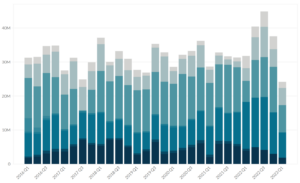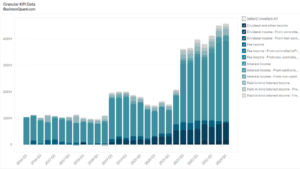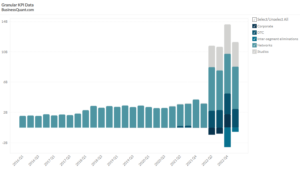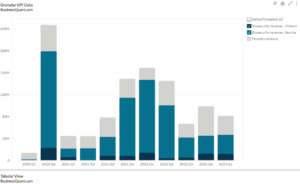
AMD’s Shipment and ASP Growth (2016-2022)
Exclusive Data
You need the Pro Plan to access KPI data
- Full access to the platform
- KPI data & segment financials on US stocks
- Financial data on thousands of stocks
- Download data in xlsx and csv formats
Pro Plan
$49 per month*
60% discount ends in:
.
About
More information
Subscribe to Pro or Enterprise plans to unlock this feature.
Contact the Analyst
Subscribe to Pro or Enterprise plans to unlock this feature.
Become a smarter investor today.
Access KPIs & Segment Financials on US stocks
This statistic highlights AMD’s Shipment growth and ASP (average selling price) growth, from its Computer and Graphics segment, from Q1 2016 onwards.
It’s evident that AMD shipment and ASP growth rates surged with the launch of its Zen architecture in 2017. AMD Shipment and ASP growth momentum faded in early 2019 as the industry underwent a phase of stagnation due to heightened trade tensions between US and China, while AMD’s Ryzen 2000-series did not have a large enough performance advantage to command top dollar.
| Metric | Q4 2018 | Q1 2019 | Q2 2019 | Q3 2019 |
| ASP Growth (YoY) | 15% | 4% | 5% | 40% |
| Unit Growth (YoY) | 17% | -8% | 0% | 10% |
As we head into 2020, it is forecasted that AMD’s growth momentum will pick again. Its new line of Ryzen 3000-series Threadripper, desktop CPUs and APUs are based on the new and improved Zen 2 architecture, and fabricated on the 7nm node, so that should ideally bolster AMD’s shipment and ASP growth over the coming quarters. These ASP and shipment gains have driven AMD’s financials higher (Read: AMD’s Revenue by Segment).
Another dynamic that’s boosting AMD Shipment and ASP growth is that Intel is facing a supply crunch. Intel hasn’t been able to migrate to the 10nm node and it has had to roll back to its 14nm production lines in an attempt to smoothen its yield issues. Intel’s supply issues have encouraged OEMs and DIY PC builders to look for AMD’s competitive processors as an alternative. It is believed that Intel won’t transition to the 10nm node, which is comparable to the 7nm that AMD is already using, until 2020 at least. This industry dynamic could continue to favor AMD and bolster its growth momentum.
It’s worth noting AMD Shipment and ASP growth rates are based only on its Computer and Graphics segment and don’t include any contribution from its Enterprise, Embedded and Semi-Custom segment. You can also read more about AMD’s Operating Margins by Segment to get a better idea of its business diversity.
Did you like AMD’s Shipment growth and ASP growth statistic?
Access more such KPI data points and segment financials on thousands of US stocks, with Business Quant.
You can get started here.
More data on US Stocks

Our Plans
Always know what you’ll pay. No hidden costs or surprises.
- Annual
- Monthly
60% discount till April 30
Pro
For serious investing
-
Company KPI data Access segment financials, non-GAAP metrics and KPI data from presentations and filings. Examples include financials by segment / region / product category, AT&T's broadband subscriber trends, Tesla's deliveries by model and lots more.
-
Stock research tools Features include : stock screener, stock comparison, industry financials, stock warnings, advanced charting tools, timeseries tables, scatter charts, financial statements, stock reports, SEC filings, stock ratings, institutional and insider ownership data. There are 200+ financial items and ratios on thousands of US stocks.
-
Industry data & tools Access premium operating data on 40+ industries. Examples include market share, smartphone shipments by vendor, subscribers by wireless carrier, historical gold production. There are 20,000+ such statistics.
Enterprise
For tailored workflows
-
All of Pro plan Get unfettered access to all our dashboards and dossiers.
-
Custom built features Get tailored dashboards built specially for you , based on your set of requirements, to simplify your research workflow.
-
Admin billing Back-end documentation support and multi-seat licensing.
* Billed annually, local taxes extra.
60% discount on Annual plan
Pro
For serious investing
-
Company KPI data Access segment financials, non-GAAP metrics and KPI data from presentations and filings. Examples include financials by segment / region / product category, AT&T's broadband subscriber trends, Tesla's deliveries by model and lots more.
-
Stock research tools Features include : stock screener, stock comparison, industry financials, stock warnings, advanced charting tools, timeseries tables, scatter charts, financial statements, stock reports, SEC filings, stock ratings, institutional and insider ownership data. There are 200+ financial items and ratios on thousands of US stocks.
-
Industry data & tools Access premium operating data on 40+ industries. Examples include market share, smartphone shipments by vendor, subscribers by wireless carrier, historical gold production. There are 20,000+ such statistics.
Enterprise
For tailored workflows
-
All of Pro plan Get unfettered access to all our features.
-
Custom built features Get tailored dashboards built specially for you , based on your set of requirements, to simplify your research workflow.
-
Admin billing Back-end documentation support and multi-seat licensing.
* Local taxes extra.






